Are your hamstrings the bane of your athletic existence? Or even worse, do you find hamstring tightness or pain interferes with your daily activities?
If so, you’re not alone. Research suggests hamstring injuries are some of the most common problems for NFL players and soccer players, with hamstring strains accounting for 23% of acute injuries in soccer.
Prevention is key when it comes to stopping hamstring injuries before they start. Here are some exercises to help stretch and strengthen your hamstring muscles, as well as a few pointers for mobilizing neighboring joints.
RELATED: Hamstring Mechanics During Sprinting: Insight Into Injury
How to Stretch Properly
In her usual style, mobility expert Brooke Thomas cuts to the chase about what might be causing your hamstrings to be so uptight:
Our hamstrings muscles (there are three: biceps femoris, semitendinosus, and semimembranosus, but for the purposes of this post I’ll discuss them broadly as a group) attach on our ischial tuberosity proximally, and on the femur, tibia, and fibula distally. So they attach on your pelvis, your thigh, and your lower leg. We usually think of their action as a group as knee flexors. As in, if you need to bring your heel closer to the back of your thigh, they’re on the job. But we commonly neglect to pay attention to their other action, which is to posteriorly tilt the pelvis. As in, if you want to flatten out your low back and tuck your pelvis under, they do that, too.
Sadly, many of us sit on our sacrums instead of our ischial tuberosities (the fictional “sit bones”), which means we are sitting in a posteriorly tilted pelvis all day long. Your lumbar discs and sacroiliac ligaments greatly dislike this, and so do your hamstrings. Sitting like this means the hamstrings are constantly contracted. So it’s really just plain unfair to contract your hamstrings for eight to fifteen hours of your day (because even when our workday ends, we then go home and sit on our sacrums on the couch, right?), and then get mad at them when, for somewhere in the range of two to forty minutes of your day, you attempt to stretch them and they don’t comply.
I wanted to just copy and paste Brooke’s entire article here since it’s so good. I can’t do that, so I recommend you read the rest of it here. But I couldn’t resist adding her video that details how to stretch your hamstrings the right way. In fact, watch this video before you do any other hamstring stretches in this article to make sure you’re doing them right.
3 Simple Fixes
The next three exercises suggested by yoga expert Willow Ryan won’t only help your hamstrings. You’ll probably notice relief in other areas of your body, such as your lower back and hips. Try them out and let us know how it goes.
Here are a couple simple stretches you can do with ease:
- Legs straight up wall with back on the floor – Maintain this position for 15 minutes and you may notice your pelvis, hips and sacrum realigning and adjusting, too. When the hamstrings lengthen, it reduces the strain on your lower back as well.
- Straddle while sitting with back up wall – Maintain this position for 5-10 minutes to stretch your adductors and medial hamstrings. The closer to your groin and pubic bone you receive a stretch, the more relief you may feel on your IT Band.
Read more tips from Willow in her article,Dear Willow: Help My Tight Hamstrings!
Saved By the Block
You’ve probably noticed by now the hamstrings don’t work with isolation. They’re part of a team, and when you forget to work with your team members, problems ensue. In his article, Block Lunges: Release the Quadriceps and Lengthen the Hamstrings, yoga teacher Jonathan FitzGordon explains how the hamstring muscle team works together to provide support and bear your body’s weight while standing or sitting:
My take on posture is pretty simple. I think the quadriceps tend to be both overly long and full of tension, while the hamstrings tend to be too short and tight. An overwhelming number of people tuck their pelvis during all activities. The tuck of the pelvis draws the sit bones down and forces the femur bones forward. (As shown on the right side of the picture.) The sit bones being drawn down shortens the hamstrings and the femurs pushing forward stretches the quads. It also forces the quads to bear the weight of the upper body because with the pelvis no longer aligned on top of the thighs, a person’s weight can’t transfer through the bones from the spine to the legs.
Sounds familiar? There’s that sitting thing again. To release the hamstrings, as well as the quadriceps and psoas, Jonathan suggests performing the following exercise every day for a few weeks:
Knee-Friendly Hamstring Stretches
You might be watching that lunge video and thinking, “My knees would NOT like that.” Have no fear – yoga instructor Bethany Eanes is here with three yoga poses to strengthen your hamstrings without stressing out your knees:
Triangle Pose With Arms Extended
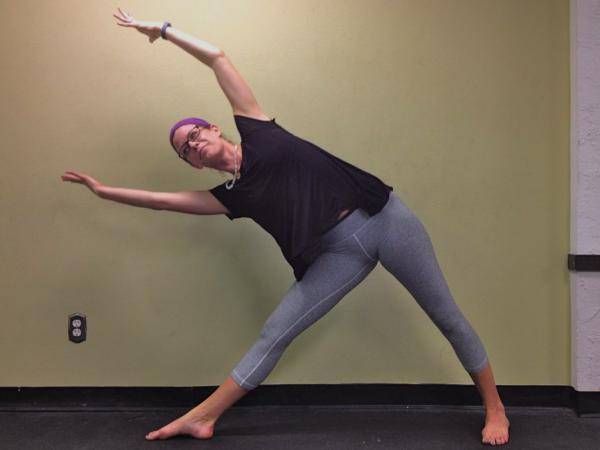
Pyramid Pose with Arms in Airplane
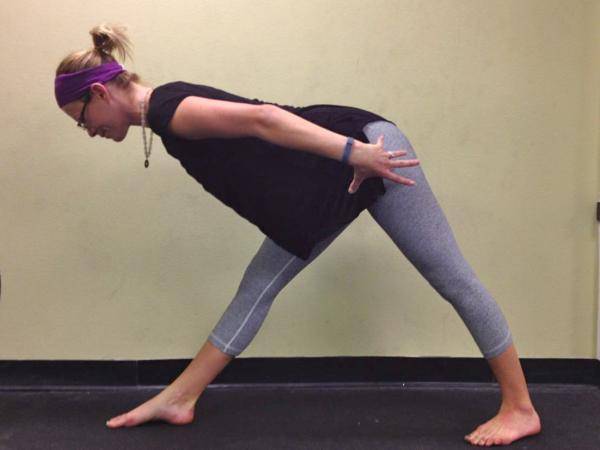
Bow Pose
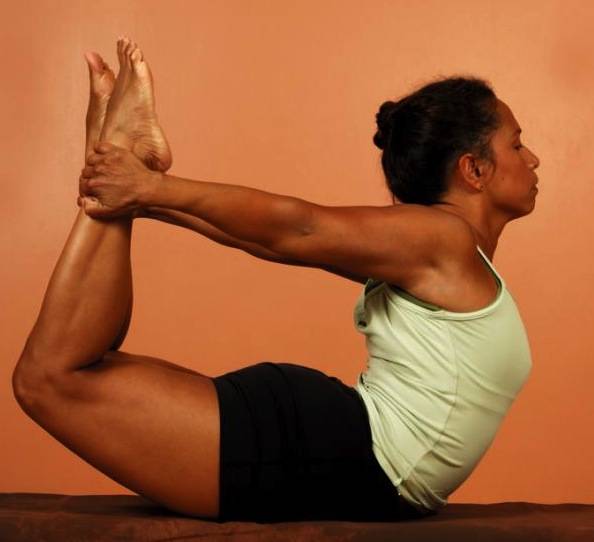
For detailed instructions on how to enter these poses safely, read Bethany’s article, 3 Yoga Poses to Strengthen the Hamstrings and Protect the Knees.
Are Your Hamstrings Even the Problem?
One final consideration, just so you don’t get too comfortable: What if your hamstrings aren’t actually the problem?
Personal trainer and yoga instructor Brandon Hofer explained how “tight hamstrings” can actually be a symptom of other underlying issues in his article, Yoga for Strength Athletes: Mobilize Your IT Band and Posterior Chain. He also revealed two of his favorite yoga poses for correcting these common issues:
One of the most common range of motion issues I come across as a trainer is a poorly-mobilized posterior chain. Many athletes say they have “tight hamstrings,” but the issue is more than just hamstrings. It’s the entire posterior chain clenching and pulling when and where it shouldn’t be, like when you attempt a kettlebell swing and end up dropping into a squat, or when yourlumbar rounds as you compensate with an exaggerated posterior pelvic tilt during the first phase of a deadlift.
Downward Dog, and its cousin the Three-Legged Dog, is one of the most popular yoga poses for a reason. Not only does it decompress and neutralize your spine, but consistent practice will correct most of the movement faults associated with kettlebell swinging and snatching, deadlifting, and overhead pressing.
You can utilize this posture before your training session as part of a mobility based warm-up, during your session between sets as a quick spinal decompression, and after your training session for something a little more engaging than “stretching.”
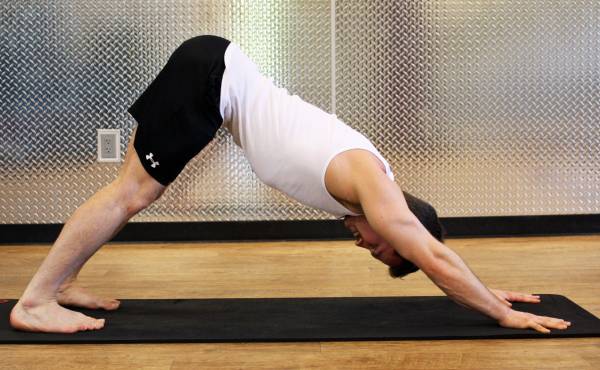
Downward Dog
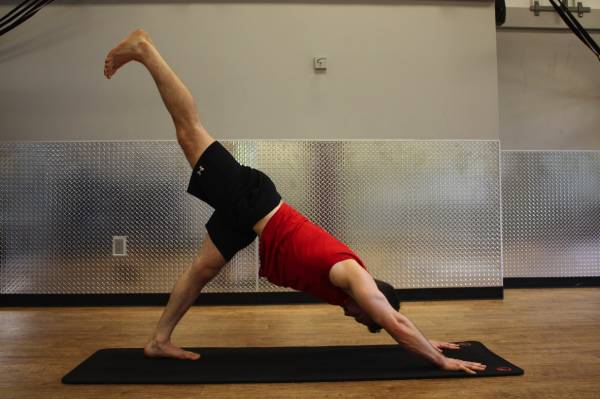
Three-Legged Dog
Add these exercises to your hamstring-stretching arsenal to lengthen and strengthen this common trouble spot. And if you’re in the short hamstring club, too, share your favorite fixes in the comment box below. Pretty much everyone could use some hamstring love.
Photos 1 and 4 courtesy of Shutterstock.
Photos 2 and 3 courtesy of Bethany Eanes.
Photos 5 and 6 courtesy of Brandon Hofer and Breaking Muscle.






